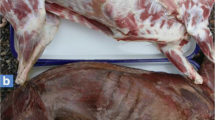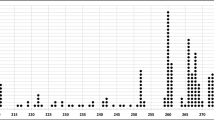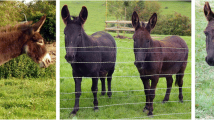Abstract
Overo lethal white syndrome (OLWS) is an inherited syndrome of foals born to American Paint Horse parents of the overo coat-pattern lineage. Affected foals are totally or almost totally white and die within days from complications due to intestinal aganglionosis. Related conditions occur in humans and rodents in which mutations in the endothelin receptor B (EDNRB) gene are responsible. EDNRB is known to be involved in the developmental regulation of neural crest cells that become enteric ganglia and melanocytes. In this report we identify a polymorphism in the equine EDNRB gene closely associated with OLWS. This Ile to Lys substitution at codon 118 is located within the first transmembrane domain of this seven-transmembrane domain Gprotein-coupled receptor protein. All 22 OLWS-affected foals examined were homozygous for the Lys118 EDNRB allele, while all available parents of affected foals were heterozygous. All but one of the parents also had an overo white body-spot phenotype. Solidcolored control horses of other breeds were homozygous for the Ile 118 EDNRB allele. Molecular definition of the basis for OLWS in Paint Horses provides a genetic test for the presence of the Lys 118 EDNRB allele and adds to our understanding of the basis for coat color patterns in the horse.
Similar content being viewed by others
References
Amiel J, Attie T, Jan D, Pelet A, Edery P, Bidaud C, Lacombe D, Tarn P, Simeoni J, Flori E, Nihoul-Fekete C, Munnich A, Lyonnet S (1996) Heterozygous endothelin receptor B (EDNRB) mutations in isolated Hirschprang disease. Hum Mol Genet 5, 355–357
Anderson DJ (1997) Cellular and molecular biology of neural crest cell lineage determination. Trends Genet 13, 276–280
Attie T, Till M, Pelet A, Amiel J, Edery P, Boutrand L, Munnich A, Lyonnet S (1995) Mutation of the endothelin-receptor B gene in Waardenburg-Hirschsprung disease. Hum Mol Genet 4, 2407–2409
Auricchio A, Casari G, Staiano A, Ballabio A (1996) Endothelin-B receptor mutations in patients with isolated Hirschsprung disease from a noninbred population. Hum Mol Genet 5, 351–354
Badner JA, Sieber WK, Garver KL, and Chakravarti A (1990) A genetic study of Hirschprang disease. Am J Hum Genet 46, 568–580
Baynash AG, Hosoda K, Giaid A, Richardson JA, Cheung J, Emoto N, Hammer R, Yanigasawa M (1994) Interaction of endothelin-3 with endothelin B receptor is essential for development of epidermal melanocytes and enteric neurons. Cell 79, 1277–1285
Bowling AT (1994) Dominant inheritance of overo spotting in paint horses. J Hered 85, 222–224
Bowling AT (1996) In Horse Genetics, (Wallingford, UK: CAB International)
Ceccherini I, Zhang A, Matera I, Yang G, Devoto M, Romeo G, Cass D (1995) Interstitial deletion of the endothelin-B receptor gene in the spotting lethal (sl) rat. Hum Mol Genet 4, 2089–2096
Chakravarti A (1996) Endothelin receptor mediated signaling in Hirschsprung disease. Hum Mol Genet 5, 303–307
Chromzynski P, Sacchi N (1987) Single-step method of RNA isolation by acid guanididium thiocyanate-phenol-chloroform extraction. Anal Biochem 162, 156–159
Coventry S, Yost C, Palmiter RD, Kapur RP (1994) Migration of ganglion cell precursors in the ileoceca of normal and lethal spotted embryos, a murine model for Hirschsprang disease. Lab Invest 71, 82–93
Edery P, Attie T, Amiel J, Pelet A, Eng C, Hofstra RMW, Martelli H, Bidaud C, Munnich A, Lyonnet S (1996) Mutation of the endothelin-3 gene in the Waardenburg-Hirschsprang disease (Shah-Waardenburg syndrome). Nat Genet 12, 442–444
Elshourbagy NA, Korman DR, Wu HL, Sylvester DR, Lee JA, Nuthalaganti P, Bergsma DJ, Kumar CS, Nambi P (1993) Molecular characterization and regulation of the human endothelin receptors. J Biol Chem 268, 3873–3879
Gariepy CE, Cass DT, Yanagisawa M (1996) Null mutation of endothelin-B receptor gene in spotting lethal rats causes aganglionic megacolon and white coat color. Proc Natl Acad Sci USA 93, 867–872
Goldberg EL (1984) An epidemiological study of Hirschsprung’s disease. Int J Epidemiol 13, 355–363
Hofstra RMW, Osinga J, Tan-Sindhunata G, Kamsteeg EJ, Stulp RP, Van Ravenswaaij-Arts C, Majoor-Krakauer D, Angrist M, Chakravarti A, Meijers C, Buys CHCM (1996) A homozygous mutation in the endothelin-3 gene associated with a Waardenburg type 2 and Hirschsprung phenotype. Nat Genet 12, 445–447
Hosoda K, Hammer RE, Richardson JA, Baynash AG, Cheung J, Giaid A, Yanagisawa M (1994) Targeted and natural (piebald-lethal) mutations of endothelin-B receptor gene produce megacolon associated with spotted coat color in mice. Cell 79, 1267–1276
Hultgren BD (1982) Ileocolonic aganglionosis in white progeny of overo spotted horses. J Am Vet Med Assoc 180, 289–292
Jackson IJ (1994) Molecular and developmental genetics of mouse coat color. Annu Rev Genet 28, 189–217
Kasafuka T, Wang Y, Puri P (1996) Novel mutations of the endothelin-B receptor gene in isolated patients with Hirschsprang disease. Hum Mol Genet 5, 347–349
Marklund L, Johansson Moller M, Sandburg K, Andersson L (1996) A missense mutation in the gene for melanocyte-stimulating hormone receptor (MC1R) is associated with the chestnut coat color in horses. Mamm Genome 7, 895–899
McCabe L, Griffin LD, Kinzer A, Chandler M, Beckwith JB, McCabe RB (1990) Overo lethal white foal syndrome: equine model of aganglionic megacolon (Hirschsprung disease). Am J Med Genet 36, 336–340
Metzger IL (1978) The overo lethal white cross in spotted horses. Thesis, The University of Missouri
Passarge E (1967) The genetics of Hirschsprang’s disease: evidence for heterogeneous etiology and a study of 63 families. N Engl J Med 276, 138–143
Passarge E (1993) Wither polygenic inheritance: mapping Hirschsprang disease. Nat Genet 4, 325–326
Pavan WJ, Mac S, Cheng M, and Tilghman SM (1995) Quantitative trait loci that modify the severity of spotting in piebald mice. Genome Res 5, 29–41
Puffenberger EG, Hosoda K, Washington SS, Nakao K, deWit D, Yanigasawa M, Chakravarti A (1994) A missense mutation of the endothelin-B receptor gene in multigenic Hirschsprang’s disease. Cell 79, 1257–1266
Schneider JE, Leipold HW (1978) Recessive lethal white in foals. J Eq Med Surg 2, 479–482
Vonderfecht SL, Trommershausen A, Cohen M (1983) Congenital aganglionosis in white foals. Vet Pathol 20, 65–70
Author information
Authors and Affiliations
Rights and permissions
About this article
Cite this article
Santschi, E.M., Purdy, A.K., Valberg, S.J. et al. Endothelin receptor B polymorphism associated with lethal white foal syndrome in horses. Mammalian Genome 9, 306–309 (1998). https://doi.org/10.1007/s003359900754
Received:
Accepted:
Issue Date:
DOI: https://doi.org/10.1007/s003359900754




